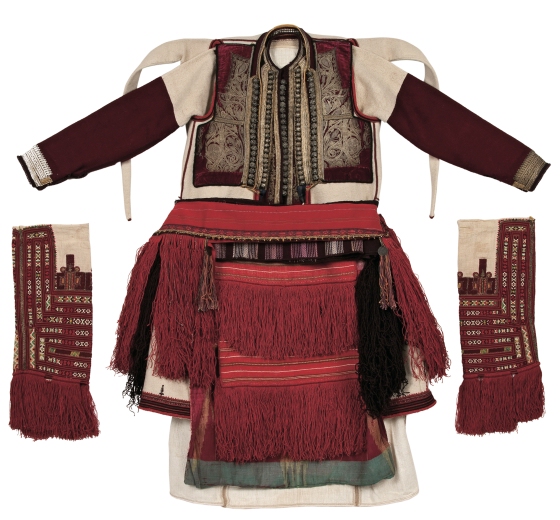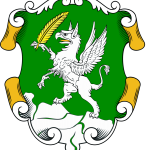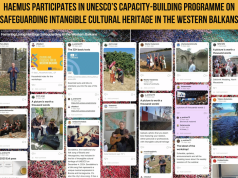
The countries of southeastern Europe maintain some of the most elaborate and diverse traditions of dress in western Eurasia. Beyond their beauty and their importance as markers of identity in a landscape of great cultural diversity, these garments also preserve strong traces of the developmental stages of modern “Western” dress, which begins with a simple string skirt.
“Resplendent Dress From Southeastern Europe: A History in Layers” ― on view at the Fowler Museum at UCLA from March 10 through July 14 ― explores the traditional garments of 12 small countries and shows the major historical and cultural influences that have shaped European rural dress.

In the past, girls in rural southeastern Europe spent their childhoods weaving, sewing and embroidering festive dress so that when they reached puberty, they could join the Sunday afternoon village dances garbed in resplendent attire.
These colorful and intensely worked garments were often adorned with embroidery, lace, metallic threads, coins, sequins, beads and, perhaps most importantly, fringe. A symbolic element, the fringe provides a reminder that the original string skirt was a marker of fertility and has carried this meaning for more than 20,000 years.
Over time, new forms of dress were added bit by bit to the simple string skirt so that by 1900, the apparel of a woman from a southeastern European village consisted of millennia of layered history in an ensemble that could weigh more than a hundred pounds. With a glance at her, an onlooker could discern not only her marital status but also her religion, wealth, textile skills and more. By emphasizing these traits — and not just her physical beauty — a girl presented herself and was chosen as a bride.
“Resplendent Dress From Southeastern Europe” features 50 stunning 19th- to 20th-century ensembles from Macedonia, Croatia, Albania, Bosnia-Herzegovina, Bulgaria, Kosovo, Serbia, Hungary, the Slovak Republic, the Czech Republic, Montenegro and Romania ― nearly all from the Fowler Museum’s substantial collection ― plus 100 individual items, including aprons, vests, jackets and robes. To complement the outstanding examples of women’s dress, the exhibition also includes several men’s garments.
All of these fascinating ensembles are displayed in an immersive environment that evokes the distinctive mountain landscape in which villagers gathered in their finery.

Ensemble from Macedonia
Woman’s ensemble, Lazaropole, Western Macedonia, 20th century
Fowler Museum, Gift of Robert Leibman
The exhibition begins by tracing the development of the earliest string skirts, which later morphed into fringed garments. Subsequent sections consider the introduction of the sleeved chemise or tunic, and then the layering of aprons, vests, gathered skirts, jackets and coats. Later sections of the exhibition show the influence of the Ottoman Empire on fashion, including the popularity of long, roomy pants, often referred to as “harem” pants in English, and adornments made from metallic braids attached in ornate patterns.
The village dance
Throughout rural southeastern Europe, dance and music have long been important means to socialize on Sundays and holidays, and during special occasions like weddings and festivals. Voluminous skirts, glorious colors and dazzling adornments show to best advantage when swirling during dance.
Bright red fringe in particular ― a feature originally evolved from the string skirts of the Paleolithic era ― stood out at dances as a symbol of fertility when worn by young women of marriageable age. Today, this dress continues to be worn on festive occasions and by older people in rural areas. In addition, folk festivals featuring dance performances ― popular with both locals and tourists ― have stimulated a revival in the wearing of regional dress. As such, dress, dance and music continue to be a mainstay of life for many.
Also on display: ‘Spomenik’
As a counterpoint to the strong cultural identities embodied in the traditional festive dress on display in “Resplendent Dress From Southeastern Europe,” the Fowler is also presenting “Spomenik: Photographs of the Monuments of Former Yugoslavia by Jan Kempenaers,” which runs from March 17 through Aug. 11.
Futuristic-looking yet dilapidated spomeniks ― monuments in Serbo-Croatian ― dot the hills and valleys of the former Yugoslavia like abandoned spaceships, tributes to a now-forgotten socialist future that would be free of ethnic divisions. From 2006 to 2009, Antwerp-based artist Jan Kempenaers traveled through the region, photographing these striking monuments.
Erected by Yugoslavian President Josip Broz Tito in the 1960s and 1970s to commemorate World War II, the spomeniks were once the sites of state-orchestrated pilgrimages for adults and schoolchildren and the focus of efforts to construct a cohesive identity for a radically heterogeneous nation. After the breakup of Yugoslavia in the early 1990s, many of the monuments were destroyed. Today, those that remain have fallen into disrepair and lie deserted and disused, subject to the indifference of a new generation.
Textiles at the Fowler Museum
The Fowler Museum collections include more than 15,000 textiles that trace the history of cloth over two millennia and across five continents. The museum is also home to the Richard and Patricia Anawalt Center for the Study of Regional Dress, an endowed research facility that advances the study of cloth and clothing traditions through teaching and research. Students and scholars, working with the Fowler Museum’s outstanding textile collections, investigate all facets of worldwide indigenous dress: the varying aesthetics of regional clothing, the range of technological solutions to cloth production and decoration, and the role of dress in defining social, religious and political identities.
Additional information
“Resplendent Dress From Southeastern Europe” is organized by the Fowler Museum at UCLA in association with the Richard and Patricia Anawalt Center for the Study of Regional Dress at the Fowler Museum. It was curated by Elizabeth Wayland Barber, a professor emerita of archaeology and linguistics at Occidental College and a research associate at the Cotsen Institute of Archaeology at UCLA, and Barbara Belle Sloan, associate director of the Center for the Study of Regional Dress.
Major funding is provided by Patricia Anawalt, R.L. Shep and the R.L. Shep Endowment Fund at the Fowler Museum. Additional support comes from Lee Bronson in memory of Rada (Radmilla) Bronson, Norma Greene, Carolyn and Charles Knobler, Mary Jane Leland, and Michael Rohde, and from the Fowler Textile Council. The hotel sponsor is Hotel Angeleno.
A same-titled book published in conjunction with this exhibition will be available this spring from the University of Washington Press.
The Fowler Museum at UCLA is one of the country’s most respected institutions devoted to exploring the arts and cultures of Africa, Asia and the Pacific, and the Americas. The Fowler is open Wednesday through Sunday from noon to 5 p.m. and Thursday from noon to 8 p.m. The museum is closed Mondays and Tuesdays. The Fowler Museum, part of UCLA Arts, is located in the north part of the UCLA campus. Admission is free. Parking is available for a maximum of $11 in Lot 4. For more information, the public may call 310-825-4361 or visit www.fowler.ucla.edu.
Source: The Fowler Museum at UCLA





